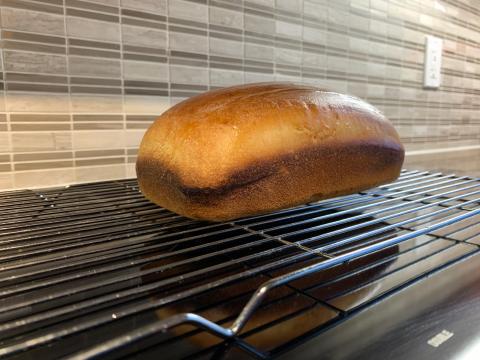This loaf came up in another discussion and DanAyo asked me to post details of the process and the recipe, something I'm glad to do with a few caveats. First, this loaf is made entirely with home milled flours meaning that your mileage may vary depending on your milling technique and the grain you're using. My starter is made with home milled rye and is maintained on my baking schedule so its vigor and flavor may be different from your results. Finally, the times for bulk ferment and proof as well as baking reflect the temperature in my kitchen and the performance of my oven. Therefore if it doesn't work to your satisfaction you've got plenty of reasons to blame it on me.
I am using a 1998 KA Heavy Duty mixer with a Mockmill attachment. The loaf is baked in a USA Pan Small Pullman pan and lid that measures 4"x4"x9". The oven is a full size electric.
My starter is made with freshly milled rye at 100% hydration, weighs about 200g and is kept in the fridge around 34 - 36f. My flour is unbolted, freshly ground hard wheat, either white or red. The recipe seems to work well with either. The pictured loaf is hard red.
On baking day the starter is taken out of the fridge and given a couple of hours to come up to room temp. I put 150g of it in the mixing bowl of my KA mixer, mill 75g of rye into the starter jar and add 75g of water, stir thoroughly and set it on the counter to double in about 4 hours. When it's done that it goes back into the fridge.
The 'discard' from the starter is in the mixing bowl (that's what makes the loaf parsimonious). I mill 25g of rye onto it and 400g of wheat. I add 1/4tsp of Ascorbic acid and use the paddle to mix in 275g of warmed, filtered water and 30g of sorghum molasses. Once everything is mixed I cover the bowl and let the mixture rest for 45 minutes.
I then use the hook to begin kneading the dough. This kneading lasts around 10 minutes. Close to the end of the initial kneading I add in 1/4tsp of Instant Dry Yeast. After I feel the gluten is beginning to be well developed I pull the ball of dough off the hook, sprinkle 9g of Pink Himalayan Salt on top of it and cover the bowl for a 10 minute rest.
At the end of that rest period I begin kneading again for at least 5 minutes. Toward the end of the second kneading I add 20g of ghee and continue kneading until it's well integrated. At that point I remove the bowl, shape the dough into a ball, cover the bowl and set it in a warm, draft free location.
The bulk ferment will last 2-3 hours depending on kitchen temp. The dough is then shaped and placed in the Pullman pan and covered with plastic wrap for final proof, another 2 hours or so.
When the highest point of the dough is even with the lip of the pan I place the lid on the pan and set it on the middle rack of a cold oven. With the temperature set for 350f I bake it from the cold start for about 33 minutes. The lid is then removed and the bake continued for another 11 minutes before the loaf is removed from the pan and cooled on a rack.
The loaf is not cut until the following day. The flavor isn't particularly sour but there's little or no hint of the small amount of yeast that's added after the starter has had about an hour's head start to work on the flours.
Here's the recipe:
150g of 100% rye starter
25g of fresh milled rye
400g of fresh milled hard wheat (red or white)
275g filtered, warmed water
1/4 tsp Ascorbic Acid (optional)
30g Sorghum molasses or honey
9g of PH salt
20g of ghee












